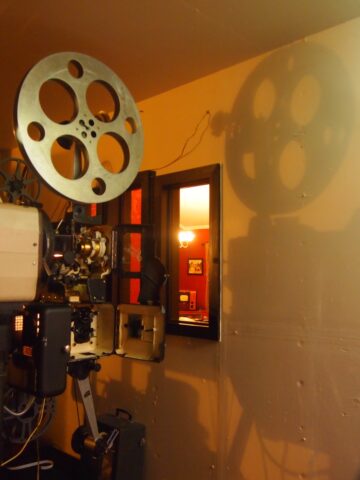I’ve mentioned my experience as a young film projectionist in the late 1980s at Harvard Square’s Janus Theatre. When the obscure topic of 35mm projection comes up, I therefore tend to pay attention.
A common question: Was the machinery easy to use? No! I was licensed by the state, and the test required safety checks – the bulbs could blind you, and generated so much heat that fire was a real risk.
And these projectors were complex. This article in Indiewire, talking about runaway costs faced by modern-day movie theaters using digital equipment, made a flat-out wrong statement about analog film projectors that needs to be corrected:
A 35mm analog film projector was a machine with a handful of parts. If one broke, theaters could be back up within a matter of hours.
 Are you kidding me? A 35mm analog film projector has hundreds of moving parts. Our theater used 25-year-old Italian film projectors made by Cinemeccanica. It looked something like the inset image (source). The precision-engineered knobs, gears, and motors were made of high-quality materials. If one of them breaks, you’re not swapping it out with a plastic doohickey from Radio Shack or a light bulb from the local hardware store. You might not even trust the pimply teenager running the film projector (me) to touch any of the interior parts or gears.
Are you kidding me? A 35mm analog film projector has hundreds of moving parts. Our theater used 25-year-old Italian film projectors made by Cinemeccanica. It looked something like the inset image (source). The precision-engineered knobs, gears, and motors were made of high-quality materials. If one of them breaks, you’re not swapping it out with a plastic doohickey from Radio Shack or a light bulb from the local hardware store. You might not even trust the pimply teenager running the film projector (me) to touch any of the interior parts or gears.
You’re going to the pros: Authorized service techs, or a specialized audio-visual supplier who may have it in stock, but is definitely not open on the weekend when these things tend to break. And, the supplier may have have to order the replacement part from Japan or Europe.
If you’re part of a chain that uses standard equipment (not a given, considering consolidation) you might be able to borrow parts or spares from your pal running the show at the multiplex across town.
Worst case scenario: Because most theaters operate two sister machines for each film (a reel can only hold ~75 minutes of film max, so you have to switch over to the second machine halfway) you can technically swap reels on a single machine with a 5 minute intermission.
The only spare parts we kept in stock in our single-screen theatre were reels and light bulbs. I was trained on how to swap out the bulb using cloth gloves – if you touched it with bare skin, the oil on your hand could cause the bulb to burst when it was lit, because they ran so hot. There was specialized venting equipment to get the hot air away from the machines and out of the building, but even still the projection room was warm.
That warmth and the gentle clicking of the film running through the analog film projectors are sensations I will never forget.

Lots of theaters couldn’t afford to purchase digital projectors. While some theaters purchased the new equipment out of pocket, others went out of business. But some were offered a loan by the movie industry. The catch? They had to give there analog film projectors to specific refuse companies for scrapping. They have warehouses full of these projectors to be scrapped; some are even in parking lots getting the weatherization treatment. Makes me sick that these precision engineering feats that are film projectors are being scrapped or rotting away instead of being sold to movie lovers – even if they may not have the space in their home to put them.